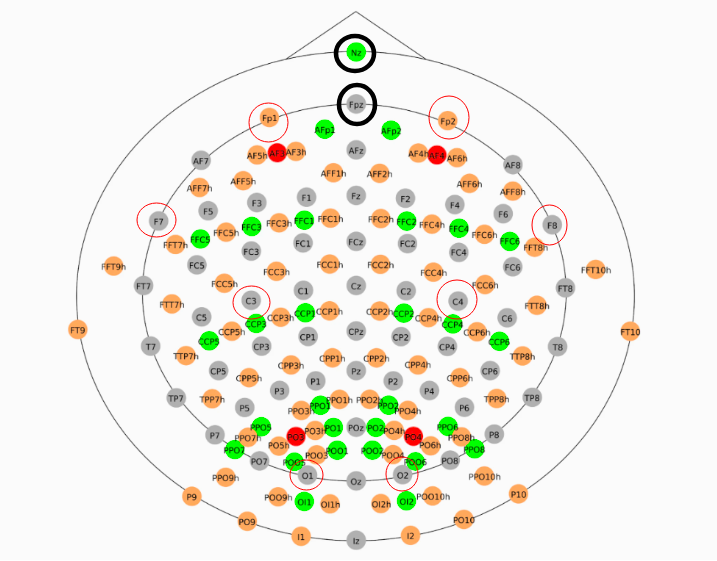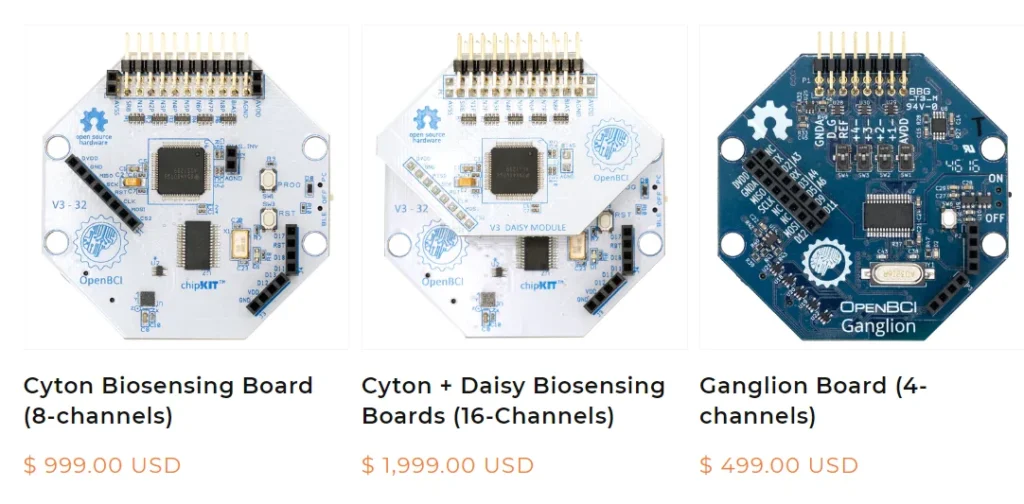A brain-computer interface establishes a direct connection between the human brain and a variety of technologies, such as computers, robotic limbs, and assistive communication tools.

click to jump:
Technical Explanation
The electroencephalogram, or EEG, technology is a main of brain-computer interfaces. The electrical activity of the brain’s billions of neurons produces EEG signals. Volume conduction is how these impulses move through the scalp and brain.
Volume conduction is the process by which electrical signals go through a conducting material, such as the scalp and brain. The electrical current that is produced when a neuron fire flows through the surrounding tissue (such as the cortex, Thalamus, Hippocampus, and Amygdala) to create a voltage gradient, which is the difference in voltage between two sites. The EEG signal is propelled across the scalp and brain by this voltage gradient.
Brain waves are recorded by electrodes mounted to our heads. Wet and dry electrodes are the two primary categories of electrodes. Typically crafted from silver or gold.

dry electrode

wet electrode
An amplified and filtered EEG signal is produced when the electrodes are positioned. To make recording the signal easier, the amplifier boosts its amplitude. The electrical muscles in the face and neck produce noise, which is removed from the signal by the filter.
Primarily, there are 4 types of steps in the brain-computer interface: Signal Acquisition, Denoising, featuring, and classification.
Signal Acquisition
In the brain-computer interface, we typically utilize electrode counts of 4, 8, 16, 32, or 64 in most cases.
These are the main key points

Here are the electrode placements for an 8-electrode EEG setup which includes the ground point
- Fp1: Positioned on the forehead to the left of the midline.
- Fp2: Positioned on the forehead to the right of the midline.
- F7: Located over the left prefrontal cortex.
- F8: Located over the right prefrontal cortex.
- C3: Positioned over the left central cortex.
- C4: Positioned over the right central cortex.
- O1: Located over the left occipital cortex.
- O2: Located over the right occipital cortex.
Ground Point:
Usually, the ground electrode is positioned in the middle or at the midline of the forehead. In the 10-20 system, it is frequently positioned at points like Fpz or the nose bridge (Nz). In order to minimize noise and reference the EEG signals to a neutral point, the ground electrode is used.
You can use these procedures to use 8 electrodes based on the 10-20 system.
First, locate the nasion, or nasal bridge, and the inion, or bump on the back of your head, as two reference points on your skull.

Second, take a measurement along your head’s midline, measuring the separation between your nasion and inion. For this, you can use a string or a measuring tape. Then, at intervals of 10%, 20%, 20%, 10%, and 10% of the entire distance, mark five points along this line. These locations are called Fz, Cz, Pz, Oz, and Iz, respectively.
Third, along the line that passes through Cz, measure the separation between the preauricular points, or the points in front of your ears. For this measurement, use a string or a measuring tape. Next, at intervals of 10%, 20%, 20%, and 10% of the total distance, mark four spots along this line. Label these points T3, C3, C4, and T4, correspondingly.

Fourth, use conductive paste or gel to attach the electrodes to these nine positions.
we have the flexibility to employ various speed systems for acquiring EEG signals. In many low-powered wearable devices, there’s an ADC (Analog-to-Digital Converter) such as ADS1293 or ADS1296, coupled with processor systems like ESP32, Arduino-based systems, or PIC microprocessor-based systems.
We can employ FPGA-based SoC systems in high-speed advanced systems to create brain-computer interface
Denoising
Denoising is the process of taking out unwanted noise from EEG data, which might have an impact on the analysis’s accuracy and quality. Mainly, there are five denoising methods.
- Time-Frequency Denoising Method: This technique makes use of the non-local means (NLM), bidimensional empirical mode decomposition (BEMD), and short-time Fourier transform (STFT) time-frequency denoising algorithm framework. After denoising, it may successfully suppress the high-frequency components of brain signals, producing a smoother brain signal waveform.
- The Wavelet Transform (WT) is a widely used and effective method for signal denoising in non-stationary signals. The ideal setting of WT’s control parameters determines its success.
- Independent Component Analysis: Since artifacts are independent of one another and the EEG data obtained from scalp electrodes can be viewed as summaries of neural activity, independent component analysis may be a powerful and efficient method for separating artifact from EEG signals.
- Metaheuristic Algorithms: The best WT parameters for EEG signal denoising are found using these techniques. Harmony search (HS), genetic algorithm (GA), particle swarm optimization (PSO), β-hill climbing (β-hc), and flower pollination algorithm (FPA) are a few examples.
- Filtering Methods: To separate the noise and maintain the integrity of EEG data, a number of filtering methods are available. Wavelets on epileptic EEG signals, adaptive filters, LPF Butterworth filters, Notch filters, and sleep EEG signals are a few examples.
These are the main denoising methods in the brain-computer interface
featuring
The continuous EEG signal is divided into epochs or segments. Each segment corresponds to a specific time window.
Primarily, we convert time-domain signals into frequency-domain signals using Fourier transformation in the brain-computer interface.
mainly we consider about 5 bands
- delta (from 0.5 to 4 Hz)
- theta (from 4 to 7 Hz)
- alpha (from 8 to 12 Hz)
- beta (from 13 to 30 Hz)
- gamma (from 30 to 80 Hz).
classification
The majority of the time, we use AI and machine learning algorithms that make use of different frequency components. For example, when using brain-computer interfaces to classify people according to psychological diseases like depression, the analysis focuses on frequency bands like Alpha Power and the theta-to-beta ratio.
Three main techniques are available for signal analysis:
- Resting State EEG Analysis: Comparing people with and without depression, differences in their patterns of brain activity can be seen. This kind of study draws attention to aberrant network patterns linked to depression.
- ERPs, or event-related potentials, are EEG reactions to certain stimuli or occurrences. Researchers examine the cognitive functions and affective reactions of depressed patients using ERPs. For example, the P300 ERP component is frequently assessed in relation to depression.
- Frequency Analysis: Alpha, beta, theta, and delta brain wave frequencies can all be examined with EEG. Depression may be associated with abnormalities in these frequencies or changes in them.
2. Open-Source Platform (OpenBCI)
OpenBCI is an Open-Source Platform for brain-computer interface

This platform provides all the components, including data acquisition boards, electrodes, wires, and software platforms.

This platform offers three main boards for 4, 8, or 16 channel acquisition. The 8 and 16-channel boards are equipped with a PIC32MX250F128B microcontroller featuring a chipKIT™ bootloader (50MHz) and a 24-bit channel data resolution ADC. The 8-channel board has a sampling rate of 250Hz for each channel, while the 16-channel board boasts a sampling rate of 125Hz for each channel.
Additionally, this platform provides a graphical user interface (GUI) for signal display.

Visit open BCI
3. Use Case

Mainly there are three areas of use in brain-computer interfaces, Medical Advancements, Assistive Technology, and Cognitive Enhancement.
In the context of Medical Advancements
- Restoring Mobility: Using robotic exoskeletons or prosthetic limbs, paraplegic people can restore their freedom and mobility.
- Encouraging people with locked-in syndrome or severe communication impairments to communicate their wants and thoughts is known as “facilitating communication.”
- Improving Therapy: By offering real-time data for diagnosis and therapy, this initiative helps treat neurological disorders like Parkinson’s disease and epilepsy.
In the realm of Assistive Technology
- Control and Independence: Allowing individuals to regain control over their environment, from operating wheelchairs to turning on lights with their thoughts.
- Communication: Providing a means for those with limited or no speech to communicate through text or speech synthesis devices.
Lastly, in the field of Cognitive Enhancement
- Memory Enhancement: Investigating the use of BCIs to enhance memory and learning processes, potentially aiding in education and personal development.
4. History of brain-computer interface
The origins of BCI may mostly be found in ancient Egypt. Hans Berger then carried out the first Electroencephalography (EEG) tests on humans in 1929.
The phrase ‘brain-computer interface’ was first used in 1973 by Professor Jacques Vidal of the University of California, Los Angeles. He also described the objectives of the Brain-Computer Interface project, which was centered on the analysis of EEG signals.
read more about the history of the brain-computer interface
openBCI tutorial
what is FPGA


You could never find the words to describe how much I loved you. No matter how beautiful the picture is or how polished your writing is, you read it quickly. To be honest, I think you should give it another chance soon. I will probably try to go on this hike again and again if you make sure it is safe.
I loved even more than you will get done right here. The picture is nice, and your writing is stylish, but you seem to be rushing through it, and I think you should give it again soon. I’ll probably do that again and again if you protect this hike.
I do agree with all the ideas you have introduced on your post They are very convincing and will definitely work Still the posts are very short for newbies May just you please prolong them a little from subsequent time Thank you for the post
My cousin suggested this website to me. I am uncertain as to whether this post was written by him, as no one else knows as much about my problem. Your website is truly remarkable.